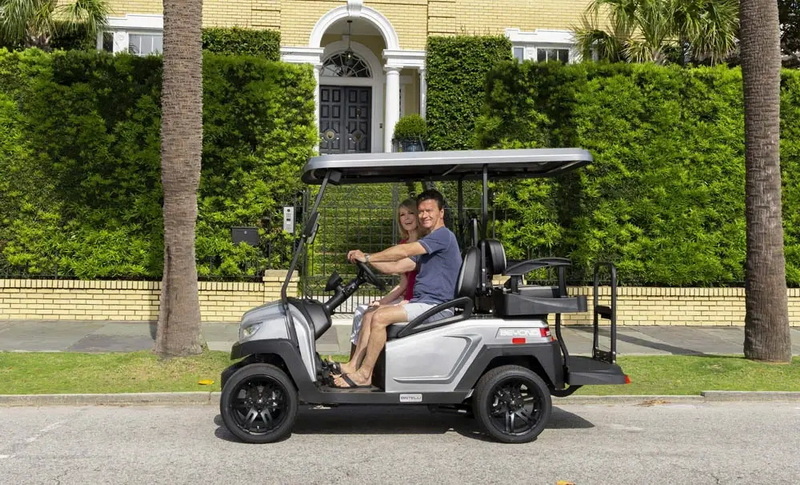Content Menu
● Understanding Street Legal Requirements
● Essential Safety Equipment
>> Lighting System
>> Mirrors
>> Windshield
>> Seat Belts
>> Horn
>> Parking Brake
>> Reflectors
>> DOT-Approved Tires
>> Speedometer
● Speed Modifications
● Legal Considerations
>> Vehicle Identification Number (VIN)
>> Registration and Licensing
>> Insurance
● State-Specific Regulations
● Environmental Considerations
● Driving Tips for Street-Legal Golf Carts
● Benefits of Street-Legal Electric Golf Carts
● Video Guide: Making Your Golf Cart Street Legal
● Conclusion
● Frequently Asked Questions
>> 1. How much does it cost to make a golf cart street legal?
>> 2. Can I drive my street-legal golf cart on any road?
>> 3. Do I need a special license to drive a street-legal golf cart?
>> 4. How fast can a street-legal golf cart go?
>> 5. Are there any environmental benefits to using a street-legal electric golf cart?
Electric golf carts are becoming increasingly popular for more than just cruising around the golf course. Many people are now using them as a convenient and eco-friendly mode of transportation in their communities. However, to legally drive your electric golf cart on public roads, you'll need to make some modifications to ensure it meets street-legal requirements. In this comprehensive guide, we'll walk you through the process of making your electric golf cart street legal, covering everything from essential safety features to legal considerations.

Understanding Street Legal Requirements
Before diving into the modifications, it's crucial to understand what makes a golf cart "street legal." Generally, a street-legal golf cart is classified as a Low-Speed Vehicle (LSV) or Neighborhood Electric Vehicle (NEV). These vehicles must meet specific federal safety standards and local regulations to be operated on public roads[1].
Key requirements typically include:
- A top speed between 20-25 mph
- Gross vehicle weight under 2,500 pounds
- Ability to operate on roads with speed limits of 35 mph or less
Essential Safety Equipment
To make your electric golf cart street legal, you'll need to install several safety features. These additions not only ensure compliance with regulations but also enhance the overall safety of your vehicle[1][2].
Lighting System
A comprehensive lighting system is crucial for visibility and signaling. Install the following:
- Headlights
- Taillights
- Brake lights
- Turn signals
- Hazard lights
Mirrors
Proper visibility is essential for safe driving. Add:
- Driver's side mirror
- Passenger side mirror or interior rearview mirror
Windshield
A DOT-approved windshield protects occupants from debris and weather elements.
Seat Belts
Install seat belts for all seating positions to ensure passenger safety.
Horn
A functioning horn is necessary for alerting other road users.
Parking Brake
A reliable parking brake is essential for securing the vehicle when stationary.
Reflectors
Add reflectors to increase visibility, especially during low-light conditions.
DOT-Approved Tires
Replace golf course tires with DOT-approved tires suitable for street use.
Speedometer
Install a speedometer to monitor and maintain legal speeds.

Speed Modifications
Most electric golf carts have a top speed of around 15 mph, which is below the minimum requirement for street-legal operation. To increase the speed:
1. Upgrade the motor: Install a more powerful electric motor.
2. Modify the controller: Adjust the controller settings to allow higher speeds.
3. Install a speed governor: Ensure the cart doesn't exceed the maximum legal speed limit.
Remember, the goal is to achieve a top speed between 20-25 mph, not to create a high-speed vehicle[2].
Legal Considerations
Vehicle Identification Number (VIN)
Most golf carts don't come with a VIN from the factory. You may need to obtain a VIN from your local DMV or transportation department to register your golf cart as a street-legal vehicle[7].
Registration and Licensing
Once your golf cart meets all safety requirements:
1. Contact your local DMV for registration procedures.
2. Obtain proper licensing for the vehicle.
3. Display a valid license plate as required by local laws.
Insurance
Obtain appropriate insurance coverage for your street-legal golf cart. Many auto insurance providers offer policies specifically for LSVs and NEVs[8].
State-Specific Regulations
It's important to note that regulations for street-legal golf carts can vary significantly between states and even local municipalities. Some states have embraced LSVs and NEVs, while others have more restrictive policies[5].
For example:
- Florida has extensive regulations allowing golf carts on many public roads.
- California requires emissions testing for gas-powered golf carts.
- Some states like Kentucky, North Carolina, and New York have more stringent restrictions.
Always check with your local authorities for the most up-to-date and accurate information regarding street-legal golf carts in your area.

Environmental Considerations
One of the major advantages of electric golf carts is their minimal environmental impact. When making your golf cart street legal, consider:
- Using energy-efficient LED lights for all lighting requirements.
- Opting for eco-friendly materials when possible for any additional components.
- Maintaining your electric motor and batteries for optimal efficiency and longevity.
Driving Tips for Street-Legal Golf Carts
Once your electric golf cart is street legal, keep these tips in mind for safe operation:
1. Obey all traffic laws and speed limits.
2. Use turn signals and be cautious at intersections.
3. Be aware of your surroundings, especially larger vehicles.
4. Avoid roads with speed limits above 35 mph unless explicitly allowed.
5. Maintain your golf cart regularly to ensure all safety features are functioning properly.
Benefits of Street-Legal Electric Golf Carts
Making your electric golf cart street legal offers several advantages:
1. Cost-effective transportation for short trips
2. Environmentally friendly alternative to traditional vehicles
3. Easy parking in congested areas
4. Lower maintenance costs compared to full-sized vehicles
5. Fun and unique way to travel around your community
Video Guide: Making Your Golf Cart Street Legal
For a visual guide on making your golf cart street legal, check out this informative video:
Conclusion
Transforming your electric golf cart into a street-legal vehicle requires careful consideration of safety features, legal requirements, and local regulations. By following the steps outlined in this guide, you can enjoy the convenience and eco-friendliness of your golf cart beyond the fairways. Remember to always prioritize safety, stay informed about local laws, and maintain your vehicle properly to ensure a smooth and legal ride on public roads.

Frequently Asked Questions
1. How much does it cost to make a golf cart street legal?
The cost can vary widely depending on the current condition of your golf cart and local requirements. On average, you can expect to spend between $1,000 to $5,000 for all necessary modifications, registration, and insurance.
2. Can I drive my street-legal golf cart on any road?
No, street-legal golf carts are typically restricted to roads with speed limits of 35 mph or less. Always check local regulations for specific restrictions in your area.
3. Do I need a special license to drive a street-legal golf cart?
In most areas, a standard driver's license is sufficient. However, some jurisdictions may have specific requirements or age restrictions for operating street-legal golf carts.
4. How fast can a street-legal golf cart go?
Street-legal golf carts are usually limited to a top speed of 20-25 mph, depending on local regulations.
5. Are there any environmental benefits to using a street-legal electric golf cart?
Yes, electric golf carts produce zero emissions during operation, making them an environmentally friendly alternative to traditional gas-powered vehicles for short trips.











































